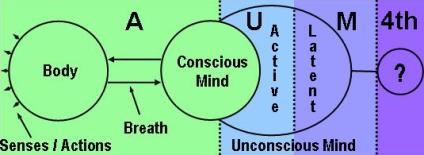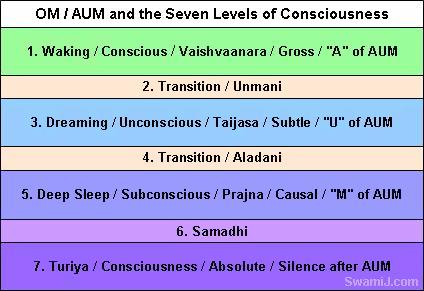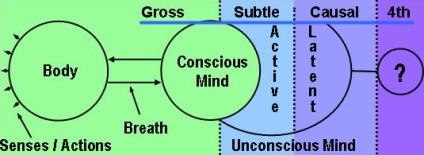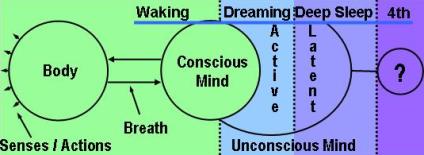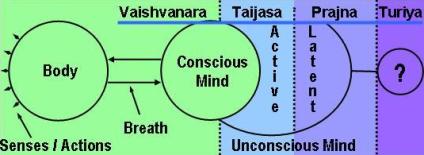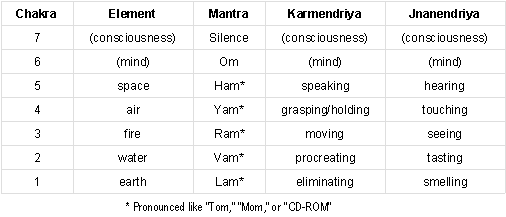|
|
It has been said that the juice of the Vedas is in the Upanishads, and the juice of the Upanishads is in the Mandukya Upanishad. OM Mantra is also suggested as a direct route to samadhi in the Yoga Sutras. The teachings of the Mandukya Upanishad are well worth deep study, discussion, reflection and contemplation. By faithfully and intently engaging these twelve verses, all of the other written and oral teachings can be explored as expansions of the foundation principles and practices encapsulated in this succinct summary. It is not only a most insightful writing, but also a complete outline for sadhana, enlightenment practices. The OM Mantra is a roadmap of the entire process of sadhana and a most practical tool for Self-Realization. (See also Mandukya Upanishad - Gaudapada's Karika) One of the other hundred-plus Upanishads, the Mukti Upanishad (mukti means liberation), explains that for those who are seeking liberation, the understanding and practicing of the principles of the Mandukya Upanishad is sufficient for attaining that realization.
Mandukya Upanishad on Om Mantra: Yoga Vedanta Meditation
See also these
articles, which relate to the levels of OM:
Om symbol and the elements of Mandukya
Upanishad:
The Self and the Absolute (1-2): 1)
Hari Om. Om-ity-etad-aksharam-idam sarvam, tasyopavyakhyanam
bhutam bhavad bhavishyaditi sarvam-omkara eva. Yaccanyat
trikalatitam tadapy omkara eva.
All is OM: Hari Om. The whole universe is the syllable Om. Following is the exposition of
Om.
Everything that was, is, or will be is, in truth Om. All else which
transcends time, space, and causation is also Om.
2)
Sarvam hyetad brahmayam-atma brahma soyamatma catushpat.
Atman has Four Aspects: All of this, everywhere, is in truth Brahman, the Absolute Reality. This very
Self itself, Atman, is also Brahman, the Absolute Reality. This Atman or
Self has four aspects through which it operates. Four
Levels of Consciousness (3-7):
3)
Jagarita-sthano
bahish-prajnahsaptanga ekonavimsatimukhah sthula-bhug vaisvanarah
prathamah padah.
First is Waking / Gross: The first aspect of Atman is the Self in the Waking state,
Vaishvanara. In this first state, consciousness is
turned outward to the external world. Through its seven instruments* and nineteen
channels* it experiences the gross objects of the phenomenal world. 4) Svapna-sthano'ntah-prajnah
saptanga ekonavimsatimukhah praviviktabhuk taijaso dvitiyah padah.
Second is Dreaming / Subtle: The second aspect of Atman is the Self in the Dreaming state,
Taijasa. In this second state, consciousness is turned
towards the inner world. It also operates through seven instruments and nineteen channels, which
engage the subtle objects of the mental realm. 5) Yatra supto na kancana
kamam kamayate na kancana svapnam pasyati tat sushuptam. Sushupta-asthāna
ekibhutah prajnanaghana
evanandamayo hyanandabhuk chetomukhah prajnastrityah padah.
Third is Deep Sleep / Causal: The third aspect of Atman is the Self operating in the Deep Sleep state,
Prajna. In this third state, there is
neither the desire for any gross or subtle object, nor any dream
sequences.
In deep sleep, all such experiences have receded or merged into the
ground of undifferentiated consciousness. Here, one is filled with the
experience of bliss, and can also find the way to clearer knowledge of the two preceding states. 6) Esha sarvesvara
esha sarvajna esho'ntaryamy-esha yonih sarvasya
prabhavapyayau hi
bhutanam.
Find the Experiencer: The one who experiences all of these states of consciousness is the
omniscient, indwelling source and director of all. This one is the womb
out of which all of the other emerges.
All things originate from and dissolve back into this source. 7) Nantah-prajnam na
bahih-prajnam,
nobhayatah-prajnam na prajnana-ghanam na prajnam naprajnam.
Adrishtam-avyavaharayam-agrahyam-
alakshanam-acintyam-avyapadesyam-ekatma-pratyayasaram, prapancopasarnam
santam sivam-advaitam caturtham manyante sa tm sa vijneyah.
The Fourth Aspect is Turiya: The fourth aspect of Atman or Self is Turiya, literally the fourth. In this
fourth state, consciousness is neither turned outward nor inward. Nor
is it both outward and inward; it is beyond both cognition and the
absence of cognition. This fourth state of Turiya cannot be
experienced through the senses or known by comparison, deductive
reasoning or inference; it is indescribable, incomprehensible, and
unthinkable with the mind. This is Pure Consciousness itself. This is the real Self. It is
within the cessation of all phenomena. It is serene, tranquil, filled
with bliss, and is one without second. This is the real or true Self
that is to be realized.
Four
Aspects of AUM (8-12): 8) So'yam-atma
adhyaksharam-omkaro dhimatram pada matra matrasca
pada akara ukaro makara
iti.
Those Four are the Same with "A-U-M" and Silence: That
Om, though described as having four states, is indivisible; it is pure
Consciousness itself. That Consciousness is Om.
The three sounds A-U-M (ah, ou,
mm) and the three letters A, U,
M are identical with the three states of waking, dreaming, and
sleeping, and these three states are identical with the three sounds and letters. The fourth
state, Turiya is to be realized only in the silence behind or beyond the other three.
9)
Jagarita-sthano vaisvanaro'karah
prathama matra. apteradimatvad-vapnoti ha vai
sarvan kamanadisca bhavati ya evam veda.
The Sound "A" is Waking / Gross: Vaishvanara is the consciousness
experienced during the waking state, and is A,
the first letter of Om. That simple sound of A is first and permeates all other sounds. One who is aware of
this first level of reality has fulfillment of all longings and is
successful. 10)
Svapna-stahnas
taijasa ukaro
dvitiya matrotkarshadu-ubhayatvad- votkarsati ha vai
jnana-santatim
samanasca bhavati
nasyabrahmavit kule bhavati ya evam
veda.
The Sound "U" is Dreaming / Subtle: Taijasa is the consciousness
experienced during the dreaming state, and is U, the second letter of
Om.
This intermediate state operates between the waking and sleeping
states, reflecting some qualities of the other two. One who knows this subtler state is
superior to others. For one who knows this, knowers of Brahman, the
Absolute Reality, will be born into his family. 11) Sushupta-sthnah prajno makras
tritiya mtr
miterapiter va minoti ha
va idam
sarvam-apitisca bhavati ya evam veda.
The Sound "M" is Deep Sleep / Causal: Prajna is the consciousness experienced during the state of
dreamless, deep sleep, and is M, the third letter of Om. It
contains the other two, and is that from which the other two emerge,
and into they recede or merge. A knower of this more subtle state can
understand all within himself. 12)
Amatras-caturtho'vyavaharyah
prapancopasamah sivo'dvaita evamomkara atmaiva samvisaty-atman-atmanam ya evam veda.
Silence after "A-U-M" is the True Self: The fourth aspect is the soundless aspect of Om. It is not
utterable and is not comprehended through the senses or by the mind.
With the cessation of all phenomena, even of bliss, this soundless
aspect becomes known. It is a state of nondual (advaita) reality—one
without a second. This fourth state, Turiya, is the real Self or true
Self. One with direct experience of this expands to Universal
Consciousness.
Swami Rama wrote a profound
book on Om Mantra and Mandukya Upanishad entitled
"Enlightenment Without God" that has been out of print for
many years (it is not "anti" God). Here is a link to a
download PDF file of this text that somebody sent me.
*Twenty-Six Principles (from verses 3-4): The seven instruments are the more macrocosmic instruments, while the nineteen channels relate more to the microcosmic, individual person.
These are explored in meditation and contemplation: All of these seven instruments and nineteen channels are the means by which the Self or Atman operates in the external world, which is Vaishvanara, the subject of this third verse of the Mandukya Upanishad. It is extremely useful, if not essential, to understand and remember these twenty-six principles, instruments, or channels. This is not just intellectual information, but rather, is a real key to the self-observation and self-awareness practices that lead to the transcendence of all of these, and the realization of the Self. If they are not conscientiously witnessed, one can be deprived of the depths of spiritual awakening. Keeping it simple: When reading about these twenty-six principles (the seven instruments and nineteen channels), it can seem very complicated. However, please keep in mind that the entire process of inner functioning is being mapped out in these principles. From that perspective, twenty-six is really not such a large number. By systematically learning about, exploring, witnessing, and transcending those few, you find yourself at the realization of the Self, the Atman, which is the goal described in other verses of the Mandukya Upanishad. Five elements: The five elements of earth, water, fire, air, and space are literally examined during meditation and contemplation, as well as witnessed in daily life. The five elements operate in conjunction with the lower five chakras (at subtle level they are called tanmatras, which are part of tattvas, or subtle constituents). The five elements align with, and operate from the five lower chakras, along with the ten indriyas and a seed mantra for each.
Five pranas: When the Prana operates in the body, it divides into five major flows called Vayus. These can be thought of as somewhat like major currents in one of the large oceans of the world, while there may be thousands of smaller currents. These five Vayus are the major currents that contain thousands of smaller currents. The five are literally witnessed and examined during meditaition and contemplation.
Ten Senses or Indriyas: The human being is like a building with ten doors. Five are entrance doors, and five are exit doors. Witnessing these ten senses is an important part of meditation, contemplation, and meditation in action.
Four functions of mind: The four functions of mind are manas, chitta, ahamkara and buddhi. To witness these four is a tremendous practice for advancing in meditation.
Witnessing: There is an extensive article on Witnessing Your Thoughts, which includes many of the seven instruments and nineteen channels outlined here in the Mandukya Upanishad.
-------
------- This site is devoted
to presenting the ancient Self-Realization path of the Tradition of
the Himalayan masters in simple, understandable and beneficial ways,
while not compromising quality or depth. The goal of our sadhana or
practices is the highest Joy that comes from the Realization in
direct experience of the center of consciousness, the Self, the
Atman or Purusha, which is one and the same with the Absolute
Reality. This Self-Realization comes through Yoga meditation of the
Yoga Sutras, the contemplative insight of Advaita Vedanta, and the
intense devotion of Samaya Sri Vidya Tantra, the three of which
complement one another like fingers on a hand. We employ the
classical approaches of Raja, Jnana, Karma, and Bhakti Yoga, as well
as Hatha, Kriya, Kundalini, Laya, Mantra, Nada, Siddha, and Tantra
Yoga. Meditation, contemplation, mantra and prayer finally converge
into a unified force directed towards the final stage, piercing the
pearl of wisdom called bindu, leading to the Absolute.
|
|
|||||||||||||||||||||||||||||||||||||||||
